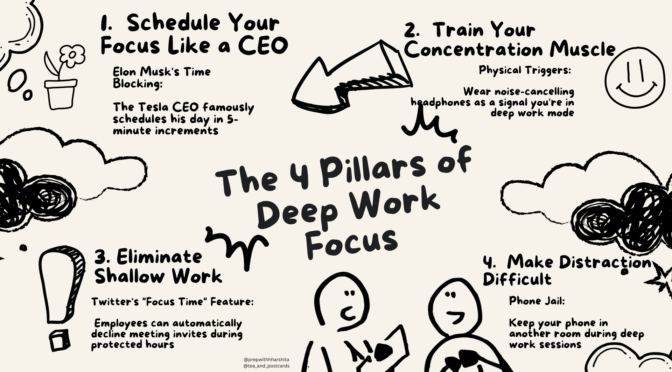The Crisis of Distraction in Modern Work
We’re living in what Cal Newport calls “the distracted decade.” The average office worker checks email 74 times a day and switches tasks every 3 minutes. Yet Newport’s research shows that elite performers share one uncommon trait: their ability to enter deep work focus states.
Real-World Examples:
- Bill Gates’ Think Weeks: The Microsoft founder would isolate himself in a lakeside cabin for uninterrupted deep work sessions that shaped company strategy
- J.K. Rowling’s Hotel Stay: The author checked into a 5-star hotel to finish Harry Potter, removing all domestic distractions
- Basecamp’s Policy: The tech company implements “no-talk Thursdays” where all communication happens asynchronously
The 4 Pillars of Deep Work Focus
1. Schedule Your Focus Like a CEO
Newport recommends treating deep work sessions like important meetings – non-negotiable and scheduled in advance.
Implementation Examples:
- Elon Musk’s Time Blocking: The Tesla CEO famously schedules his day in 5-minute increments
- The 90-90-1 Rule: Spend the first 90 minutes of your workday on your most important task
- Designated Spaces: Like author Stephen King’s famous writing office, create a distraction-free zone
2. Train Your Concentration Muscle
Our attention spans have shrunk from 12 seconds in 2000 to just 8 seconds today (shorter than a goldfish!). Rebuilding focus requires deliberate practice.
Focus-Building Techniques:
- The 20-Minute Rule: Commit to 20 minutes of uninterrupted work before allowing any breaks
- Physical Triggers: Wear noise-cancelling headphones as a signal you’re in deep work mode
- Attention Resets: Practice brief meditation sessions between work blocks
Read more : Atomic Habits quotes

